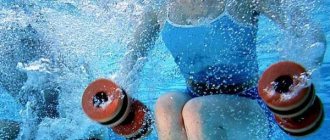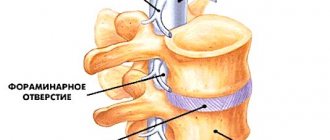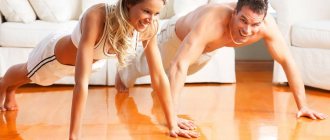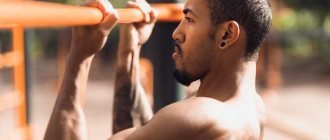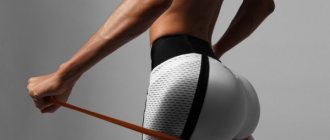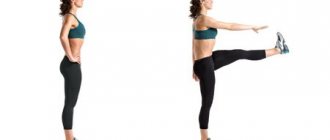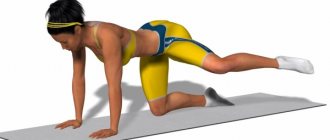From this article you will learn:
- What are the benefits of exercise therapy for the lumbar region?
- The effectiveness of exercise therapy for the lumbar region and the main contraindications
- 10 principles of exercise therapy for the lumbar region
- Features of exercise therapy for osteochondrosis of the lumbar spine
- What you need to know about exercise therapy for the lumbar region
- How to prepare for lumbar exercise therapy
- Effective exercise therapy for the lumbar region depending on the stage of the disease
- Gentle physical therapy exercises for osteochondrosis of the lumbar spine
- Exercise therapy training exercises for osteochondrosis of the lumbar spine
- 5-minute exercise therapy for the lumbar region
- Exercise therapy for the lumbar region with a fitball
- Exercise therapy of the lumbar region according to the method of Bubnovsky and Evdokimenko
Exercise therapy for the lumbar region is one of the most effective methods of treatment and prevention of complications of spinal diseases.
Physical therapy exercises take into account all the features of the pathologies of this zone. But in order to defeat the disease, you need not only to ensure that they are performed correctly, but also to be aware of the existing contraindications.
What are the benefits of exercise therapy for the lumbar region?
Nowadays, almost everyone has heard about spinal osteochondrosis. According to the World Health Organization, 80% of the Russian population has pathologies of the musculoskeletal or musculoskeletal systems. This applies not only to older people, but also to the younger generation aged 29 to 49 years.
Many people feel back pain. It causes discomfort and reduces performance. After therapy, some patients never manage to return to their previous lives, because the disease becomes chronic. This significantly interferes with the return of performance to the previous level or even provokes its cessation.
Back pain is most often related to osteochondrosis. The pathology is very common and can affect anyone.
Osteochondrosis is accompanied by metabolic disorders in intervertebral cartilage and discs. As a result, the muscular and skeletal systems change. It has been proven that the spine has a significant impact on the internal organs, which means they are also subject to pathological transformations. Many doctors say that the most effective therapy for osteochondrosis is physical activity. Therefore, we advise you to pay special attention to exercise therapy for the lumbar spine.
How does osteochondrosis develop?
The spine contains from 33 to 35 vertebrae, and between them are elastic discs. Due to them, it has flexibility and elasticity. The disc has a core covered with cartilage above and below, and along its contour there is a fibrous ring.
Osteochondrosis negatively affects blood circulation and metabolism in the spine. In this regard, the discs dry out, decrease in height, and become less durable and elastic. The fibrous ring does not cope with its function of holding the spine, which leads to its protrusion. In addition, a rupture may occur, resulting in an intervertebral hernia. The consequence of these disorders can be mobility and curvature of the spinal column.
A healthy spine is a reality, but only with an active lifestyle and moderate sports activity. Considering that the age of modern technology forces us to spend most of our time sitting at a computer, do not forget about exercise therapy for the lumbar region. After all, this is the most effective method of treating spinal diseases, as well as their prevention.
Therapeutic exercise has a positive effect on the trophism of elastic discs. As a result, joint mobility improves, the spine is saturated with blood, and its bone components are destroyed more slowly. Exercise therapy for the lumbar region helps to recover after surgery and helps strengthen the back muscles.
Physical therapy is especially recommended for the following population groups:
- Elderly people.
- For those who have previously had vertebral injuries.
- People diagnosed with flat feet and club feet.
- For those who are constantly in a non-standard position.
- People with weak muscles and ligaments.
Osteochondrosis according to the place of occurrence can be classified into osteochondrosis of the cervical, thoracic and lumbosacral spine.
The effectiveness of exercise therapy for the lumbar region and the main contraindications
During movement, the lumbar and sacral regions of the spine receive the main load. The vertebrae of the first zone are very mobile, unlike the vertebrae of the second zone. The latter are a fixed articulation of five vertebrae. Exercise therapy for the lumbosacral region helps strengthen the muscle corset, helps muscles that are constrained by spasms, and relieves pain in them after a pinched nerve.
Gymnastics alternately relaxes and tenses the muscles, which leads to improved blood flow. After an illness, the tissue receives stress and becomes stronger. Classes involve performing various exercises to train specific muscle groups. Exercise therapy is used for hernia of the lumbar spine.
Carrying out physical therapy of the lumbar region on a regular basis contributes to:
- Relief from lower back pain.
- Training of spinal muscle tissues.
- Normalization of joint mobility and blood flow in them.
- Relaxation of spasming muscles.
- Improving blood circulation in the pelvic organs.
- Increasing immunity and general tone of the body.
Exercise therapy for the lumbar region will be effective only if the exercises are performed correctly. Let's look at the basic rules:
- If you are doing physical therapy for the first time, be sure to contact an instructor. Your goal is the right exercises, not quick results.
- In case of exacerbation of the disease, you need to adhere to a special training program and only under the supervision of a trainer.
- Warm up your muscles and ligaments thoroughly before starting exercise. Massage the sacrum, because it bears the greatest load.
- Increase the difficulty gradually. The first workout should include a warm-up and the simplest movements. Duration no more than 20 minutes.
- It is not recommended to eat 1–1.5 hours before class.
- Perform exercise therapy for the lumbar and sacral region on a regular basis. Avoid long breaks. Only in this case can the disease be overcome.
Recommended articles on the topic:
- How to massage the abdomen for weight loss: different techniques for health and beauty
- Stone massage: description, benefits, methods
- MRI of three parts of the spine: when is it necessary and what are the features of the procedure
Undoubtedly, physical therapy is very useful, but not for everyone. Exercise therapy for the lumbar region has a number of contraindications:
- Any bleeding of the body, including uterine.
- The presence of malignant tumors.
- Increased body temperature.
- The period of exacerbation of any chronic disease.
- Swelling and cramps, poor circulation in the legs.
- In the presence of an inflammatory process of any organ. May be accompanied by general malaise or fever.
If, while performing exercise therapy for the lumbosacral region, you notice at least one of the symptoms listed below, consult a doctor immediately. The lesson plan may need to be adjusted:
- Sharp pain.
- Receiving microtraumas and other damage.
- Malaise and deterioration of health.
- Exacerbation of a disease associated with the spine or lumbosacral region.
How to warm up your muscles
Before starting any training complex, it is necessary to do a warm-up, which will warm up the muscles and prepare the joint apparatus for the exercises.
Pelvic rotations. Take an upright position with your feet shoulder-width apart. Place your palms on the lumbar region. Make circular movements to the right and left. Should be repeated several times.
Lateral bends help stretch muscle fibers. Take a vertical position, clasp your palms, leaning toward your left and right feet in turn. In a bent position, place your palms on the floor, between your feet, and hold for five seconds. Slowly and smoothly return to the starting position.
Take a supine position on your chest . Extend your arms behind your head. Raise your upper body using your back muscles. Fix the maximum position and lie on the anterior abdominal wall. It is necessary to repeat the exercise, slowly, 8 times.
How the workouts work
With a correctly formulated therapeutic-physical complex:
- Smooth muscles relax, stretch, and pain disappears.
- Blood circulation in the lumbar spine improves, helping to normalize the flow of nutrients to the spine.
- All muscle groups of the back are strengthened, the intervertebral space expands, from where the pinched nerve is released.
To improve the quality of life and overall well-being, it is recommended to carry out treatment activities regularly, without skipping.
When to see a doctor
Pain syndrome can be caused by a number of serious reasons. Before starting exercises, you should consult a doctor to clarify the pathology. An appointment with a doctor is required if:
- The pain does not go away for several weeks.
- When the body moves, a crunching sound is heard in the lumbar region.
- Inability to fully carry out movements due to pain.
- The pain syndrome is accompanied by headache, weakness, nausea, dizziness, and numbness of the extremities.
Features of exercise therapy for osteochondrosis of the lumbar spine
Most often, pain is felt in the lumbar spine, since it bears the main load. This is due to the anatomy of the human body structure.
Symptoms of osteochondrosis of the lumbosacral region include pain in the legs and lower back. Their cause lies in irritation of the spinal nerve roots. Swelling forms around the irritated area of the root, increasing the pain and causing it to spread to the muscles. The affected area is affected by the resulting spasm. The process is a vicious circle. But it can be interrupted by influencing the muscle system and strengthening the muscle corset.
We recommend
Anti-wrinkle facial massage: 10 effective techniques Read more
How to do this? Exercise therapy for the lumbar region, massage and useful habits in everyday life will help you here. If pain is observed in the lower back or legs, it is necessary to perform gymnastics in a lighter form.
The objectives of exercise therapy for osteochondrosis of the lumbar spine are to:
- relax and stretch tense back muscles;
- strengthen lymph and blood circulation in the lumbar region.
Follow the principles of gymnastics described above. Clearly remember what not to do, and then exercise therapy for the lumbar region will be useful and effective.
Benefits of training
- Strengthened and developed muscles reduce the likelihood of lower back pain. If you start training the lumbar region in adolescence, this will help you avoid scoliosis and osteochondrosis. In adulthood, an intervertebral hernia is formed when the lower back muscles are poorly developed.
- The muscle corset is strengthened. Thanks to this, the spine is not subject to stress when lifting heavy objects.
- Strengthened tendons and ligaments help keep your back straight and your posture graceful.
- Weak muscles are the main cause of compression of the intervertebral discs, which become less elastic over time, causing them to gradually wear out. A set of exercises reduces the manifestation of this process.
What you need to know about exercise therapy for the lumbar region
The basic requirements for physical therapy are as follows:
- Classes can be started only after pronounced pain has been eliminated.
- During an exacerbation of osteochondrosis, it is recommended to do only simple movements.
- Training should be carried out on a regular basis during remission of the disease.
- Increase the range of motion and number of repetitions gradually.
- Watch your breathing, it should be measured and calm.
- Movements should be smooth. If you feel pain, you should end the session.
- The first training should be carried out strictly under the supervision of an instructor.
- Before classes, contact a specialist for advice and a program.
- Wear only breathable clothing.
If you have problems with the lumbar spine during exercise therapy, it is prohibited to:
- Use maximum loads at the very beginning of your workout.
- Make movements that lead to painful sensations.
If osteochondrosis worsens, perform exercises only in bed.
During exercise therapy for hernias and protrusions of the lumbar and sacral regions, it is contraindicated to lift weights while standing, do leg presses while lying down, jump and run.
How to prepare for lumbar exercise therapy
Physical therapy may be prescribed by a doctor after the results of the examination. Don't forget about the rules that will help you make it effective:
- The best time for classes is before lunch. The last meal should take place 1.5 hours before they start.
- Every workout should start with a warm-up. It helps warm up muscles and ligaments, prepares the heart for stress.
- During the exercise, use a roller under your knees at the correct height (the thigh and shin are perpendicular to each other).
- Record the exercises you perform in your diary and monitor the results.
For osteochondrosis, there is a whole complex of gymnastics. Exercises vary in difficulty and stages. Follow the lesson plan without combining them with each other.
The lumbar exercise therapy program is divided into blocks that are intended for a specific stage.
The first stage is carrying out exercise therapy in the acute period . As simple and slow movements as possible.
The second stage is the subacute period . If the pain has decreased, you can increase the load, but gradually.
The third stage is remission . The pain has stopped, complex exercises are included.
Choose loose clothing that will not interfere with your workout. We recommend paying attention to a cotton T-shirt or tank top, shorts or sweatpants. If you exercise outside in cold weather, use woolen items.
Inventory you will need:
- Gymnastic ball.
- Swedish wall.
- Pillow for the knees.
- Fitness mat.
How to pump up your lower back muscles - Exercises
To pump up your lower back muscles, you need to lie on your stomach and try to raise your legs as high as possible towards your back. Do 3 sets of 10 repetitions.
Do squats with or without additional weight. To pump up your lower back , you need to do simple squats with or without additional weight. These could be dumbbells or a barbell. The main thing is to keep your back straight during the exercise so as not to injure it.
Pull-ups on a horizontal bar with weights. If you want to pump up your lower back and its volume, you first need to learn how to simply do pull-ups on the horizontal bar at least 10 times, and after that take additional weight and do pull-ups with it. This will help your lower back begin to gain volume and strength.
Push-ups with clapping. To pump up your lower back, you need to try to do push-ups with clapping or just do simple push-ups 50-100 times per set every day.
Running in the evenings. It is also good for the lower back to run in the evenings or ride a bike. This will give you more vitality and health and will strengthen and speed up the muscles of the lower back and legs. Find out: gymnastics for the lower back.
How to pump up your lower back muscles - Recommendations
To pump up your lower back muscles, you don't need to put a lot of stress on your lower back. Start with simple gymnastics, running in the evenings and cycling.
When you are sure that this is easy for you, start doing weightlifting, doing squats, push-ups and pull-ups with additional weight.
But only if you have already started and learned how to properly do pull-ups, push-ups and squats without additional weight.
Make sure you eat right so that your lower back muscles can grow, this requires protein, but don't get carried away with it too much. Eat fish 2 times a week, meat every other day, and also don’t forget to eat 2-3 boiled eggs in the evening.
Do simple gymnastics or fitness, as the lower back does not need a lot of stress to avoid injuring it.
Train your weight in the evening, and do gymnastics and warm-up in the morning, then you will be healthy, happy and your muscles will grow much faster and easier.
Effective exercise therapy for the lumbar region depending on the stage of the disease
1. Acute period.
Exercise therapy for exacerbation of osteochondrosis of the lumbar spine should be carried out only under the supervision of a trainer. Make slow movements. If pain occurs, training should be stopped. The exercises are performed from a lying position.
- It is necessary to develop the feet by performing movements of flexion and extension. First together, then after each other. Increase the pace whenever possible. Clench your fingers into a fist and then unclench them.
- I. p. – bend your legs at the knee joint. Extend one leg, your heel should slide across the bed. Repeat for the other leg. Do eight reps.
- Raise your hand up. Once you lower it, repeat for the other hand.
- Bend your left leg and move your right leg to the side. Repeat, switching the position of your legs with each other. The exercise loads the lumbar region. Avoid sudden movements. They can put increased pressure on nerve cells and aggravate osteochondrosis.
- I. p. – put your hands on your shoulders. Move in a circle. First clockwise and then counterclockwise.
- Rest your thighs on the bolster. Straighten your legs at the knee joint one at a time.
- As you exhale, bend your arms, trying to touch your shoulders. As you inhale, straighten, touching your thighs with your fingertips.
- I. p. – bend your legs at the knee joint. Move one knee to the side and return to the starting position. Repeat the same with the other one.
- Stretch your arms up. At the same time, pull your socks towards you. After lowering your arms, relax.
- I. p. – bend your legs at the knee joint. Spread and bring your knees together. You can diversify the movements by moving your knees first to one side, then to the other.
- Try to pull your bent knees one after the other towards your stomach. Help with your hands when doing this.
We recommend
Therapeutic massage for the back: features, indications and contraindications More details
2. Subacute period.
If there is an improvement in the course of the disease, the pain has subsided, you can diversify exercise therapy for the lumbar spine with more dynamic movements.
- I. p. – bend your legs at the knee joint. Straighten your right one up. Repeat for the left, four times on each. Do not straighten your leg completely if you experience pain.
- Lean on the bed with your arms bent. Try to arch your chest as much as possible. After completing the exercise, relax.
- In a lying position, you need to bend your legs and raise your back area in the sacrum area. Try to lean on your lower spine.
- Tighten and relax your buttocks.
- Bend your legs one after the other. While straightening them, press down on the bed with your foot and try to arch your lower back a little.
- Lie down and bend your legs. Raise your head while contracting your abdominals and buttocks. If the exercise is easy, try raising your pelvis a little.
3. Remission.
Exercise therapy for osteochondrosis of the lumbar spine in remission can be supplemented with complex movements. At the same time, the load increases, which means you need to carefully monitor your condition even without pain. Physical overexertion is dangerous and can lead to a sudden exacerbation of the pathology.
- I. p. - lying on the side. Pull one thigh toward your stomach first, then the other. Try to do the exercise all the way, thereby stretching the lower back muscles as much as possible. Perform five to seven repetitions on each leg.
- I. p. - on all fours. Imagine an obstacle and carefully crawl under it.
- I. p. - sitting on a hard surface, hands on knees. The back is straight. Slowly lean back, tensing your abdominal muscles. Stay a while. Return to the starting position at the same pace.
- I. p. - on all fours. Arch your back while lowering your head. Make reverse movements: arch your back, raising your head up.
- Stand up straight. Bend forward, trying to reach your toes with your hands. The chest should be pressed against the hips as much as possible. The exercise is also effective from a sitting position.
- I. p. - on all fours. Raise your legs bent at the knee joint and bend your lower back slightly. Movements help relieve symptoms of osteochondrosis.
- The legs are bent at the knee joint. Sit on them, and your heels should be level with your buttocks. Reach up and interlock your fingers. Sit on the floor, changing direction: first left, then right.
- I. p. - on all fours. Raise your arm and opposite leg. Stay in this position for a while. After returning to the starting position, repeat with the other limbs. Do five times for each side.
Exercises to Reduce Back Pain
The next complex is primarily aimed at reducing pain in the back and is carried out slowly, measuredly, and breathing should remain free.
(1) - Gluteal bridge
Take a lying position on your back on the floor, with your legs bent at the knees. Lift your pelvis up and freeze in this state for a few seconds. Exhale as much as possible, slowly lowering to the original position.
(2) - Boat
Roll over onto the front abdominal wall, stretch your arms along your body, palms up. Raise your head, shoulders and lower limbs at the same time. Your torso should be similar to a boat shape. This exercise helps eliminate pain in the sacrolumbar spine.
(3) - Stretching the back flexors
Now lie down on your back. The left leg must be bent at the knee, pulling it with your hands towards the chest area. The same should be repeated with the right leg. Then, you need to pull both limbs towards your chest. In this position, you should freeze for a few seconds, slowly, rocking on your back.
(4) - Back stretch
Take a chair and sit on it. Grasp its lower edge with your hands, and pressing tightly, bend forward and backward. This movement will eliminate congestion in the back, improving circulatory circulation. This exercise is useful for people who spend a lot of time sitting in the office.
(5) - Back warm-up
Take a knee-elbow position. Smoothly lower yourself onto your buttocks until they touch your heels. You must repeat the exercise 7 times.
Gentle physical therapy exercises for osteochondrosis of the lumbar spine
1. Lying on your back.
- Hands at your sides, legs together. As you inhale, pull your arms up, and as you exhale, lower them. Number of repetitions – 4-5.
- Bend and straighten your feet while clenching and unclenching your fists. Do it 10 times.
- Rotate your feet in a circle. In each direction 4-6 times.
- Pull your knees to your chest one at a time. Do 6-8 reps.
- Move your right arm and leg to the side, for example. Repeat in the same way for the left limbs. Do 4-6 repetitions.
- Clasp your fingers in a “lock” at the back of your head. Raise your head while pulling your toes towards you. Number of repetitions – 8.
- Hands at your sides. As you inhale, stretch your arms up, while simultaneously pulling your toes in the opposite direction from you.
- Place your legs bent at the knee joint, shoulder-width apart. Use your knee to touch the opposite foot, and vice versa. Do 4-6 times.
- Exercise “bicycle”, simulating pedaling. Repeat five circles back and forth.
- Place your hand on your stomach. Take a deep breath into your belly and then exhale slowly. Number of repetitions – 3-4.
- Stretch your left hand along your body, and stretch your right hand up. Repeat the exercise, changing the position of your hands. Do 10–12 times.
- Spread your arms to the sides, feet shoulder-width apart. With your left hand, reach your right hand. Repeat the exercise for opposite limbs. Number of repetitions – 6–10.
- Pull your knees towards your chest with your hands. First the left knee, then return to the starting position and repeat the exercise with the right. Do 6-8 times.
2. Exercise therapy lying on your side.
- Swing your arm and leg upward. Repeat about five times.
- Pull your knees to your chest: 6-8 reps.
- Swing your leg forward and backward. Repeat 6-8 times.
Perform the exercises in the same way, lying on the other side.
3. Exercises while standing on all fours.
- First move one hand to the side, then the other. Do 10–12 reps.
- Swing your leg back, straightening it. Repeat with the other leg. The quantity for each is 8–10.
- Pull your left knee towards your right hand. Repeat, switching sides of limbs. Do 6-8 times.
- Pull one knee toward your chest. After this, take your leg back, the toe should slide along the floor. At the same time as this movement, you need to sit on the opposite heel. Perform the exercise in the same way with the other leg.
- Swing your straight leg up and back. At the same time, pull your opposite hand up. Repeat similarly for the other leg and arm. Do 6-8 times.
- The legs are fixed in one position, and move your hands to the right and left sides. Repeat five times in each direction.
- Without lifting your hands from the floor, try to sit on your heels. The exercise is performed slowly. Do 6-8 times.
- Without lifting your hands from the floor, sit first on your left buttock and then on your right. Repeat 6-8 times.
- Place your hands on the floor and raise your head. Arms straight. Lower your head to your chest and arch your back, then arch it back. Make movements at a slow pace. Number of repetitions – 8–10.
Stretching exercises for the lower back muscles
This complex is a workout designed to stretch the back. They relieve pain in the lumbar region and help reduce the risk of injuries and pinching in the future.
Tilts towards toes
Strengthening the lower back at home is only possible with regular daily or every other day training. It is often used as a warm-up, but its benefits are greater after the training process.
- Move your toes apart and begin to slowly lean towards them with your hands, without bending your knees. If you can’t reach your toes, it means your leg and back muscles are not stretched enough.
- Try to hold in this position for as long as possible. If it becomes easy, then go even lower and endure the pain in the lower back that appears when the back muscles are stretched.
- Repeat 2-3 approaches a day 10 times. Over time, the stretch will improve and the pain will go away.
Reverse extension
Extensions are the exact opposite of the previous exercise. There you need to reach the big toes, but here the heels are the maximum target. It is not difficult to do, but it requires correctness and order of execution.
- Get on your knees.
- Lower your arms back, bend your back and try to reach your heels. This “work” is much more complicated than it initially seems, but the effect is considerable. Exercise strengthens the muscles of the lumbar region, corrects posture, and relaxes the muscles of the spine.
- Repeat about 3 sets of 20 times.
Kitty
If your lower back hurts, then you need to do a “cat”. It helps stretch the back muscles and greatly helps with sprains and pinches. It's as simple to do as twice two.
- Get on all fours.
- Then bend your back as low as possible and hold this position for 15 seconds.
- Then slowly rise in your back and try to rise as high as possible, but without lifting your limbs from the mat. Hold this position for 15 seconds and return to the starting position.
- Repeat 20-25 times 4 times. You can take a day's rest if you feel it's hard.
Forward bends
Traditional bends, familiar from childhood physical education lessons, bring considerable benefits to those who regularly perform them. They help strengthen the lower back muscles and reduce the risk of injury.
- First you need to take a pose in the form of a right angle.
- Next, you need to widen your legs as much as possible and begin to bend towards the center with your hands. Try to touch the floor with your fingers as far away as possible from yourself.
- Stay in this position for 30 seconds, then slowly rise back up. Repeat at least 15 times a day.
Butt lift
If we talk about the most effective exercises, then, of course, lifting the buttocks will be included in this list. It brings results within a week and makes the body noticeably more attractive.
- To do the exercise correctly, you need to take a horizontal position, take a deep breath and raise your buttocks approximately so that an angle of 45 degrees is formed. This lift will relax your back, and at the same time pump up your buttocks.
- Repeat at least 20 times a day.
Straight leg bends
These slopes are very similar to the previous ones, but differ in a few small ways.
- Firstly, you need to bend over with straight legs and, preferably, reach your toes with your fingers.
- Secondly, they do not need to be done with a large number of repetitions, as we do with regular inclines. It is enough to do about 5 repetitions per day.
- Thirdly, here you need to linger not for 30 seconds, but for a minute, in order to finally “knead all the bones and muscles” and allow the spinal regions to relax.
All the safe exercises described above are very simple to do and have great benefits for your health. They strengthen and stretch your back, but also your legs, arms and even some abdominal muscles.
Exercise therapy training exercises for osteochondrosis of the lumbar spine
For exercise therapy of the lumbar region, training exercises are indicated while the pain subsides. During the acute stage they are prohibited.
Tasks:
- Completely form the muscle corset.
- Normalize the range of motion in the leg joints.
- Repeat the number of exercises that include movements in the lumbar region strictly in accordance with the training plan.
1. Lying on your back.
- Bend your legs at the hip and knee joints. The shins should rest on the support. Join your fingers behind your head into a “lock.” Lift your head and shoulders off the floor. Do 6-8 times.
- The shins rest on the support. Hold the ball between your feet. Move it to the left, then to the right. Do 6-8 reps.
- Hold the heavy ball with your feet. The shins rest on the support. Your task is to pull your knees towards your chin, lifting your head off the floor. Perform 6–8 times.
- Bend your legs at the hip joint. The shins should rest on the support. Take dumbbells in your hands and stretch them along your body. Try to sit down. Do 6-8 times.
- Take dumbbells in your hands and move them to the right. At the same time, tilt your knees to the left. Repeat 6-8 times.
- Bend your knees and hold the ball between your feet. Take dumbbells. Try to sit down and hold this position. Do 6-8 reps.
2. Lying on your stomach.
- Stretch your hands in front of you. Raise your head and shoulders at the same time. Move your right arm behind your back, accompanying this movement by turning your torso to the right. Repeat the same with your left hand.
- Place your arms straight behind your back. At the same time, lift your head, shoulders and upper body off the floor. Raise your legs with your knees bent. Repeat 6-8 times.
- The legs need to be bent and then straightened at the knee joint in turn. Only 15–20 times.
Don't forget to take your heart rate before and after your workout. Its optimal value is 120–140 beats per minute. Exceeding the normal heart rate indicates that the load is high for you.
Back complex from Dr. Bubnovsky
There are a number of training methods developed by Dr. Bubnovsky. The exercises are aimed at eliminating pain in the back and lumbar region.
(1) - Walking on all fours
A physical activity that has shown good results is walking on all fours. Use it as a warm-up.
(2) - Raising legs from a lying position
Option A. Take a lying position and relax. The legs should be bent at the knees and the hands should be clasped behind the head. You should prepare a cold compress in advance by placing it under the lumbar region. At the same time, press your head to your chest (twisting) and tighten your lower limbs. At the same time, your elbows should touch your knees.
Option B. Place your hands freely along the body. Bend your legs alternately at the knee joint. Also use a cold compress, placing it under the lumbar region.
| (3) — Tilts to the sides Take a vertical position, spread your legs shoulder-width apart. Now you should lower yourself to your left and right legs, leaving your back straight without bending. You should also not bend your knees. |
| (4) - Hanging knee raises on the bar Hang from the horizontal bar. Bend your knees, lifting them towards your chest. More trained people raise their legs forward. |
5-minute exercise therapy for the lumbar region
- Lying on your stomach, legs straight, bend your arms at the elbows and press them to your body. Lean on your straight arms and lift your upper body off the floor. Turn your head first in one direction, then in the other. Return to the starting position and relax. Do 2-3 repetitions.
- Lying on your stomach, stretch your arms forward. Legs remain straight. Raise your torso while simultaneously performing a crawl motion with your arms. Repeat 4-6 times.
- Similar to the previous exercise, move your arms using the breaststroke technique. Do 4-6 reps on each arm.
- I. p. - lying on your stomach, hands pressed to your chin. Crawl on your bellies. The movement involves pulling the knee towards the elbow. Repeat 4-6 times.
- The situation is similar to that described above. Lift one of your straight legs up, point your toes down. Repeat the exercise with the other leg. Do 4-6 times.
- Raise your arms and legs at the same time. Hold this position and after a few seconds return to the starting position. Relax. Do 3-4 repetitions.
A set of exercises to strengthen the lower back at home
You can pump up your back both in the gym and at home. Access to exercise equipment and equipment significantly increases the effectiveness of training, but to maintain muscle tone, it is enough to exercise at home.
Forward bends (no weight)
This is a beginner movement for anyone just starting to strengthen their lumbar region. Recommended even if there are problems to strengthen the muscle corset.
Technique:
- Stand straight, feet shoulder-width apart, arms crossed over your chest.
- Lean forward as low as possible while keeping your back straight.
- Without pausing, return to the starting position at the same pace.
Exercise "Superman"
The main movement for pumping your back at home. The benefits are superior to hyperextension (without weights).
Technique:
- Take a lying position on your stomach, legs at shoulder level, arms straight forward (palms facing each other).
- At the same time, lift your chest and legs off the floor, bending at the waist.
- Hold the position for 2 to 5 seconds, depending on your fitness level.
- Repeat the movement.
Read more about the superman exercise →
Gluteal bridge
An effective movement that is necessarily included in any complex.
Technique:
- Lie on the floor with your back. Place your feet on your feet and bend your knees. Hands are on the floor.
- Lift your pelvis off the floor and lift it so that your body forms one straight line from your knees to your chest.
- Hold the position for 2-5 seconds, then slowly return to the starting position.
To complicate the movement, focus on one leg (put the other leg in front of you without touching the floor).
Learn more about the glute bridge exercise →
Static hyperextension
Unlike the gym version of the exercise, this variation does not require a machine. It is enough to fix your feet on any surface.
Technique:
- Secure your legs in any way (with the help of a sofa, the help of a partner, etc.).
- Extend your lower back, lifting your body up.
- Hold the position for 10-20 seconds.
Do 3 to 5 sets per workout.
Read more about hyperextension at home →
Exercise therapy for the lumbar region with a fitball
- "Locust". Lie on the fitball with your stomach and take turns lifting your arms and legs.
- Hyperextension. The stomach and thighs lie on the ball. Hands behind your head, legs extended back. As you inhale, bend forward, and as you exhale, return to your starting position. The exercise affects the back, do it smoothly.
- Half bridge. I. p. – lying on the floor on your back, put your feet on the fitball at an angle of 90 degrees. As you exhale, you need to straighten your legs and raise your pelvis. While inhaling, take the starting position.
- I. p. similar to the previous paragraph. Grab the ball with your feet, clasp your hands behind your head. Pick up the exercise ball.
- Twist/"flugel". Back on the floor, feet on a fitball. Hands are spread to the sides. Roll the ball with your legs in different directions. Your goal is to touch your knees to the floor.
Effective exercise therapy for the lumbar region involves repeating these exercises about 20 times.
Recommendations for lower back training
Before training, be sure to warm up.
This will warm up the muscles and ligaments and prepare them for the upcoming loads.
The lumbar muscles are strong, but medium and light weights are used to target them, with an emphasis on correct execution technique and smooth movement.
Rep Range:
- for hyperextension - 10-20 repetitions in 1 approach
- for slopes - 8-15
Optimal training frequency:
- for beginners – 3 times a week
- for intermediate level – 2 times
Beginners usually use hyperextension.
The average level alternates 2 exercises - in 1 lesson hyperextension (2-3 sets of 15-20 times), in 2 - bending over with a barbell (or, as an option, deadlift).
Bends are performed in 3 sets of 8-12 repetitions, deadlifts are performed in 3 sets of 6-10 repetitions.
As for the advanced level, they usually train the lower back once a week, performing 1-2 exercises on it.
You can also pump up your lower back at home. For this, as a rule, the “Boat” exercise is used.
At the beginning, it is performed with your own body weight, and later pick up a light weight. The main thing is to make smooth and controlled movements.
There are many options for implementation. These are lifts of opposite arms and legs, lifting the body with straight arms, with bent arms, and so on. Read more about how to replace hyperextension at home here.
Exercise therapy of the lumbar region according to the method of Bubnovsky and Evdokimenko
Sergey Bubnovsky is a rehabilitation specialist by profession, the author of a large number of exercise therapy complexes for joints, recognized by official medicine.
Pavel Evdokimenko is a rheumatologist, a member of the highest level of the Academy of Medical Sciences of the Russian Federation. Among his works are a huge number of books that describe recommendations for the treatment of arthritis and arthrosis.
Doctors Bubnovsky and Evdokimenko developed an effective set of exercises. You can familiarize yourself with the technique of their implementation, which will make physical therapy of the lumbar spine more effective, in the video.
- Lying on your stomach, reach your buttocks with your heel, bending your legs one at a time. The head is turned in the opposite direction. Hold the position for 10 seconds. After this, relax for a few seconds and repeat the movement again.
- I. p. - on all fours. Arch your back and hold this for five seconds. After that, relax. Performing the exercise from the side resembles the behavior of a cat on its hind legs, which is why it has a similar name.
- I. p. - lying on your back. First pull one leg towards your stomach, then the other. Help with your hands. Tighten your muscles for seven seconds and then relax.
- I. p. - lying on your back. Wrap your arms around your legs and pull them towards your stomach. Tighten the muscle tissue for 10 seconds, then relax.
- I. p. - sitting on a chair. Bend over slowly. Your task is to thoroughly stretch your back. As you inhale, tighten your lower back muscles for six to seven seconds, and as you exhale, relax.
Video instructions for exercise therapy of the lumbar spine:
.
Nowadays, you no longer have to spend a lot of time performing complex and unpleasant procedures at home. It is much easier to seek help from real professionals - the Veronika Herba beauty and health center, equipped with effective and modern equipment.
Why clients choose Veronika Herba beauty and health center:
- This is a beauty center where you can take a course of exercise therapy for the lumbar region at a reasonable cost, and you will be treated not by an ordinary cosmetologist, but by one of the best specialists in Moscow. This is a completely different, higher level of service!
- You can receive qualified help at any time convenient for you. The beauty center is open from 9:00 to 21:00, seven days a week. The main thing is to agree with your doctor in advance on the date and time of your appointment.
Sign up for a consultation with a specialist by phone +7 (495) 085-15-13, and you will see for yourself!


